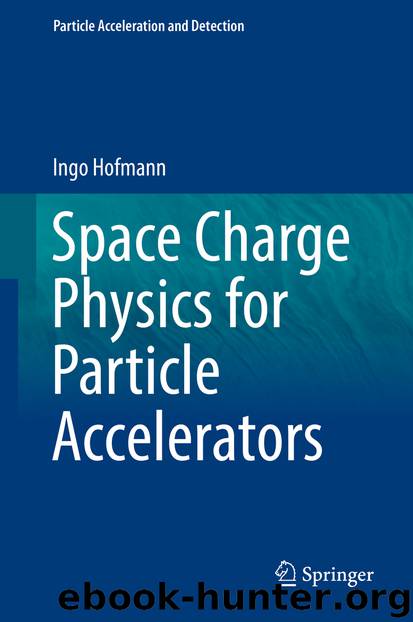Space Charge Physics for Particle Accelerators by Ingo Hofmann

Author:Ingo Hofmann
Language: eng
Format: epub
Publisher: Springer International Publishing, Cham
The bottom graph of Fig. 6.2 shows the corresponding self-consistent simulation for a KV-distribution, which confirms the peanut boundary of the core-test-particle model. The core is unstable under the action of the large mismatch, which proliferates particles into the originally unpopulated tail region, from where they can access the halo region as analysed by Jameson in [2] and Gluckstern in [6].
The peanut-shaped boundary is used by Wangler in [8] to derive scalings for the maximum halo radius of round beams. The dominant parameter in this model is the mismatch parameter μ, defined as ratio of the initial core radius (where the phase space ellipse is upright) to the matched beam radius. In Fig. 6.3 the ratio of the maximum particle amplitude from simulation to the rms size of the matched beam is plotted versus the mismatch parameter μ. The space charge tune depression has a minor effect, also the halo radius predicted by this model is quite insensitive to the choice of initial distribution.
Fig. 6.3Comparison of maximum halo radius from the core-test-particle model (curve) with multiparticle simulations for a waterbag distribution (squares and circles from different space charge routines) as function of mismatch parameter μ, and for a round beam in continuous focusing (Source: [8])
Download
This site does not store any files on its server. We only index and link to content provided by other sites. Please contact the content providers to delete copyright contents if any and email us, we'll remove relevant links or contents immediately.
The Complete Stick Figure Physics Tutorials by Allen Sarah(7307)
Secrets of Antigravity Propulsion: Tesla, UFOs, and Classified Aerospace Technology by Ph.D. Paul A. Laviolette(5309)
Thing Explainer by Randall Munroe(3875)
The River of Consciousness by Oliver Sacks(3535)
The Order of Time by Carlo Rovelli(3144)
How To by Randall Munroe(3031)
A Brief History of Time by Stephen Hawking(2959)
I Live in the Future & Here's How It Works by Nick Bilton(2934)
The Great Unknown by Marcus du Sautoy(2645)
What If?: Serious Scientific Answers to Absurd Hypothetical Questions by Randall Munroe(2637)
Midnight in Chernobyl by Adam Higginbotham(2483)
Blockchain: Ultimate Step By Step Guide To Understanding Blockchain Technology, Bitcoin Creation, and the future of Money (Novice to Expert) by Keizer Söze(2444)
Networks: An Introduction by Newman Mark(2358)
The Meaning of it All by Richard Feynman(2298)
Easy Electronics by Charles Platt(2281)
The Tao of Physics by Fritjof Capra(2227)
Midnight in Chernobyl: The Untold Story of the World's Greatest Nuclear Disaster by Adam Higginbotham(2176)
When by Daniel H Pink(2082)
Introducing Relativity by Bruce Bassett(2076)
